
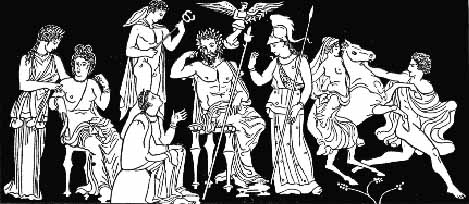


Twelve Titan Gods and Goddesses:
Oceanus and Tethys,
Hyperion and Theia,
Coeus and Phoebe,
Cronus and Rhea,
Mnemosyne, Themis,
Crius, Iapetus
Children of Hyperion:
Eos, Helios, Selene
Daughters of Coeus:
Leto and Asteria
Sons of Iapetus:
Atlas, Prometheus, Epimetheus, Menoetius
The 12 Titans gods, also known as the elder gods, who ruled the Earth
before the Olympians overthrew them. The ruler of the Titans was Cronus
who was dethroned by his son Zeus. Most of the Titans fought with Cronus against Zeus and were punished by being banished to Tartarus.
In Greek mythology, the Titans were a race of powerful deities that ruled during the legendary Golden Age. The Titans were twelve from their first literary appearance, in Hesiod, Theogony; pseudo-Apollodorus, in Bibliotheke, adds a thirteenth Titan Dione, a double of Theia, aka Medusa. The six male Titans are known as the Titanes, and the female as the Titanides ("Titanesses"). The Titans were associated with various primal concepts, some of which are simply extrapolated from their names: ocean and fruitful earth, sun and moon, memory and natural law. The twelve first-generation Titans were led by the youngest, Cronus, who overthrew their father, Uranus ('Heaven'), at the urgings of their mother, Gaia ('Earth').
The Titans later gave birth to other Titans, notably the children of Hyperion (Helios, Eos, and Selene), the daughters of Coeus (Leto and Asteria), and the sons of Iapetus - Prometheus, Epimetheus, Atlas, and Menoetius; all of these descendants in the second generation are also known as "Titans". The Titans preceded the Twelve Olympians, who, led by Zeus, eventually overthrew them in the Titanomachy ('War of the Titans'). The Titans were then imprisoned in Tartarus, the depths of the underworld, with the exception of a few.
Greeks of the Classical age knew of several poems about the war between the gods and many of the Titans, the Titanomachy ("War of the Titans"). The dominant one, and the only one that has survived, was in the Theogony attributed to Hesiod. A lost epic Titanomachy attributed to the blind Thracian bard Thamyris, himself a legendary figure, was mentioned in passing in an essay On Music that was once attributed to Plutarch. And the Titans played a prominent role in the poems attributed to Orpheus. Although only scraps of the Orphic narratives survive, they show interesting differences with the Hesiodic tradition.
These Greek myths of the Titanomachy fall into a class of similar myths of a War in Heaven throughout Europe and the Near East, where one generation or group of gods by and large opposes the dominant one. Sometimes the Elder Gods are supplanted. Sometimes the rebels lose, and are either cast out of power entirely or incorporated into the pantheon. Other examples might include the wars of the Æsir with the Vanir and Jotuns in Scandinavian mythology, the Babylonian epic Enuma Elish, the Hittite "Kingship in Heaven" narrative, and the obscure generational conflict in Ugaritic fragments. The rebellion of Lucifer from Christianity could also fall under this category.
In Hesiod's Theogony the twelve Titans follow the Hundred-handers and Cyclopes as children of Ouranos, heaven, and Gaia, the Earth. Ouranos considers Cronus monsterous, and so imprisons him in the bowels of the Earth. Cronus, aided by the Hundred-handers and Cyclopes, then sets upon his father, castrates him, and sets himself up as king of the gods, with Rhea as his wife and queen.
Rhea bears a new generation of gods to Cronus, but in fear that they will overthrow him, he swallows them all one by one. Only Zeus is saved: Rhea gives Cronus a stone in swaddling clothes in his place, and places him in Crete to be guarded by the Kouretes.
Once Zeus reaches adulthood, he subdues Cronus by force. Using a potion concocted with the help of Gaia, his grandmother, forcibly cause Cronus to vomit up Zeus's siblings. A war between the younger and many of older gods commences, in which Zeus is aided by the Hundred-handers, Gigantes, and Cyclopes, who have once again been freed from Tartarus. Zeus wins after a long struggle, and casts many of the Titans down into Tartarus.
And yet the older gods leave their mark on the world. Some of them - like Mnemosyne, Gaia, Rhea, Hyperion, Themis and Metis - had not fought the Olympians, and become key players in the new administration. The Titans also leave behind a number of offspring, some of whom may also be counted as Titans, most notably the sons of Iapetus - Prometheus, Epimetheus, Atlas, and Menoetius. Many ancient sources follow Hesiod closely, with minor variations: Apollodorus adds Dione as a thirteenth Titan.
Surviving fragments of Orphic poetry in particular preserve some variations on the myth.In one Orphic text, Zeus does not simply set upon his father violently. Instead, Rhea spreads out a banquet for Cronus, so that he becomes drunk upon honey. Zeus chains him and castrates him. Rather than being consigned to Tartarus, Cronus is dragged still drunk to the cave of Night, where he continues to dream and prophesy throughout eternity.
By and large Neopagan views of Titans can be considered 'New Age'. Many of the ancient myths are often conveniently reinterpreted as metaphor or seen as man's account of the divine. As such rather or not most modern beliefs regarding the Titans are grounded in actual mythology is often irrelevant to many Neopagans of today. In the United States Hellenistic Neopagan sects often have a special place for the Titan gods of ancient Greece, in particular Gaia, Cronus, Hecate, Hyperion, Theia, and Themis. It is sometimes argued that most of the beliefs regarding these Titan gods are inspired by popular fiction and entertainment media and not by actual mythology.
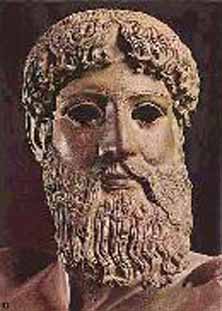
In Greek mythology, Coeus (also Koios) was the Titan of intelligence. Titans are the giant sons and daughters of Uranus (Heaven) and Gaia (Earth). With his sister Phoebe, Titan of Brilliance and the Moon, Coeus fathered Leto and Asteria. Leto copulated with Zeus (the son of fellow Titans Cronus and Rhea) and bore Artemis and Apollo.As with the other Titans, Coeus was overthrown by Zeus and other Olympians.
In Greek mythology, Crius (Kreios, the "Ram") was one of the Titans in the list given in Hesiod's Theogony, a son of Uranus and Gaia. The least individualized among them, he was overthrown in the Titanomachy. M.L. West has suggested how Hesiod filled out the complement of Titans from the core group, adding three figures from the archaic tradition of Delphi, Koios, Phoibe, whose name Apollo assumed with the oracle, and Themis. Among possible further interpolations among the Titans was Kreios, whose interest for Hesiod was as the father of Perses and grandfather of Hekate, for whom Hesiod is an "enthusiastic evangelist".
Consorting with Eurybia, daughter of Earth Gaia and Sea Pontus, he fathered Astraios and Pallas as well as Perses. The joining of Astraios with Eos, the Dawn, brought forth Eosphoros, the other Stars and the Winds.
Joined to fill out lists of Titans to form a total that made a match with the Twelve Olympians, Crius/Kreios was inexorably involved in the eleven-year-long war between the Olympian gods and Titans, the Titanomachy, however without any specific part to play. When the war was lost, Crius/Kreios was banished along with the others to the lower basement of Hades called Tartarus. From his chthonic position in the Underworld, no classical association with Aries, the "Ram" of the zodiac, is ordinarily made.
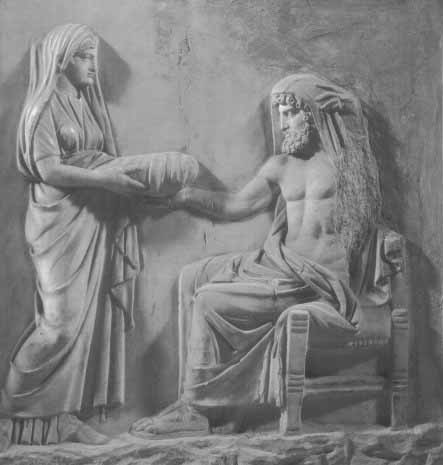
Cronus "horned"), also spelled Cronos or Kronos, is often confused with Chronos/Khronos.
In Greek mythology, Cronus was the leader and the youngest of the first generation of Titans. His mother was Gaia, and his father was Uranus, whom Cronus envied.
Uranus hid the youngest children of Gaia, the one-hundred armed giants (Hecatonchires) and the one-eyed giants, the Cyclopes, in Tartarus so that they would not see the light, rejoicing in this evil doing. This caused pain to Gaia, so she created a great sickle and gathered together Cronus and his brothers to ask them to obey her. Only Cronus was willing to do the deed, so Gaia gave him the sickle and set him in ambush. Cronus ambushed his father and castrated him, casting the severed member into the sea. From that which spilled from Uranus and fell upon the Earth came forth the Gigantes, Erinyes, and Meliae. From that which was cast into the sea came forth Aphrodite. For this, Uranus called his sons Titans, meaning "strainers," for they strained and did presumptuously a fearful deed, for which vengeance would come afterwards.
Cronus was identified in antiquity with the God Saturn of Roman mythology. The period of his rule was said to be a golden age on Earth, honored by the Saturnalia feast. Beginning on December 17 of each year, during the festival known as the Saturnalia, the Golden Age was restored for seven days. All business stopped and executions and military operations were postponed. It was a period of goodwill, devoted to banquets and the exchange of visits and gifts. A special feature of the festival was the freedom given to slaves, who during this time had first place at the family table and were served by their masters.
In an alternate version, a more benevolent Cronus overthrew the wicked serpentine Titan, Ophion. In doing so he released the world from bondage and for a time ruled it justly.
After dispatching Uranus, Cronus re-imprisoned the Hecatonchires, the Gigantes, and the Cyclopes and set the monster Campe to guard them. He and Rhea took the throne as King and Queen of the gods. This time was called the Golden Age, as the people of the time had no need for laws or rules; everyone did right, so there was no need.
Cronus sired several children by Rhea: Demeter, Hera, Hades, Hestia, and Poseidon, but swallowed them all as soon as they were born, since he had learned from Gaia and Uranus that he was destined to be overcome by his own son as he had overthrown his own father. But when Zeus was about to be born, Rhea sought Uranus and Earth to devise a plan to save him, so that Cronus would get his retribution for his acts against Uranus and his own children. Rhea gave birth to Zeus in Crete, handing Cronus a stone wrapped in swaddling clothes (also known as the Omphalos Stone) which he promptly swallowed.
Then she hid Zeus in a cave on Mount Ida in Crete.
According to varying versions of the story:
2. He was raised by a goat named Amalthea, while a company of Kouretes, soldiers, or smaller gods danced, shouted, and clapped their hands to make noise so that Cronus would not hear the baby's cries.
3. He was raised by a nymph named Adamanthea. Since Cronus ruled over the earth, the heavens, and the sea, she hid him by dangling him on a rope from a tree so he was suspended between earth, sea, and sky and thus, invisible to his father.
Zeus forced Cronus to disgorge the other children in reverse order of swallowing: first the stone, which was set down at Pytho under the glens of Parnassus to be a sign to mortal men, then the rest. In some versions, Metis gave Cronus an emetic to force him to disgorge the babies, or Zeus cut Cronus' stomach open. Then Zeus released the brothers of Cronus, the Gigantes, the Hecatonchires, and the Cyclopes, who gave him thunder and the thunderbolt and lightning, which had previously been hidden by Gaia. In a war called the Titanomachy, Zeus and his brothers and sisters with the Gigantes, Hecatonchires, and Cyclopes overthrew Cronus and the other Titans. Cronus and the Titans were confined in Tartarus, a dank misty gloomy place at the deepest point in the Earth. Ironically, Zeus also imprisoned the Hecatonchires and the Cyclopes there as well.
Cronus was worshipped as a corn god, from his association with the Golden Age. He was a god of the harvest, grain, nature, and agriculture. He was usually depicted with a sickle, which he used to harvest crops as well as castrate his father. In Athens, on the twelfth day of every month (Hekatombaion), a festival called Kronia was held in honor of Cronus and to celebrate the harvest.
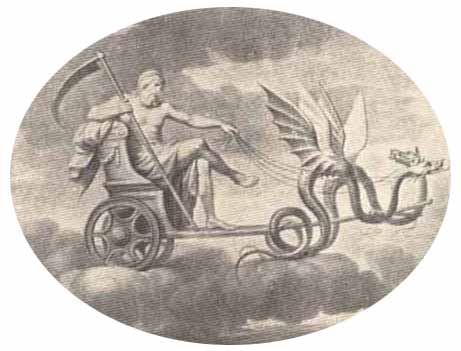
Cronus as Saturn Time, Omega and Related
Hyperion was the Titan god of light, the father of the three shining gods of heaven - Eos the Light of Dawn and Day, Helios the Sun, and Selene the Moon.
In the Homer's Iliad and Odyssey the sun god is called Helios Hyperion, 'Sun High-one'. But in the Odyssey, Hesiod's Theogony and the Homeric Hymn to Demeter the sun is once in each work called Hyperonides 'Son of Hyperion' and Hesiod certainly imagines Hyperion as a separate being in other places.
Hyperion is often considered the 'God of Observation' and is the brother of Theia the 'Goddess of Sight.'
In later Greek literature Hyperion is always distinguished from Helios as a Titan, the son of Gaia 'Goddess Earth' and Uranus 'God Sky', and the father of Helios 'God Sun', Selene 'Goddess Moon' and Eos 'Goddess Dawn' by his sister Theia 'Goddess Sight'.
Hyperion plays virtually no role in Greek cult and little role in mythology, save in lists of the twelve Titans. Later Greeks intellectualized their myths.
Modern interpretations of Hyperion by Neopagans, particularly Hellenistic sects in the United States, include the interpretation that he is the all seeing, and subsequently all knowing, god of observation. Others believe that Hyperion holds ultimate reign over the positions of the stars and the heavens, and can at times reveal celestial messages to careful observers. Hyperion is seen as impartial and unconcerned with mortals.
Hyperion is believed to play a role in the final judgment of a mortal soul, particularly making observations about one's virtuous and ill deeds before Hades, and adding weight to the scales held by Themis.Some modern pagans burn oils and incense to Hyperion and pray for worldly knowledge, or in some cases extended sight. There are those who believe that extended sight is impossible to control, and that some things in the universe are beyond mortal comprehension and should remain unseen. Others claim that extended sight can include seeing into Tartarus (hell) and may result in madness, thus some sects discourage active worship of Hyperion. Most sects that include the worship of Hyperion also include the worship of Hecate, and more commonly Theia. Such sects typically encourage experimentation with the paranormal.
In Greek mythology Iapetus, or Iapetos, was a Titan, the son of Uranus and Gaia, and father (by an Oceanid named Clymene or Asia) of Atlas, Prometheus, Epimetheus, and Menoetius and through Prometheus and Epimetheus and Atlas an ancestor of the human race. Iapetus is the one Titan mentioned by Homer in the Iliad (8.47881) as being in Tartarus with Cronus.
Iapetus' wife is normally a daughter of Oceanus and Tethys named Clymene or Asia.
But in Aeschylus's play Prometheus Bound, Prometheus is son of the goddess Themis with no father named (but still with at least Atlas as a brother).
Since mostly the Titans indulge in marriage of brother and sister, it might be that Aeschylus is using an old tradition in which Themis is Iapetus' wife but that the Hesiodic tradition preferred that Themis and Mnemosyne be consorts of Zeus alone. But it would be been quite within Achaean practice for Zeus to have taken the wives of the Titans as his mistresses after throwing down their husbands.
Iapetus is sometimes equated by Creationists with Japheth, the son of Noah, based on the similarity of their names, though scholars of Indo-European linguistics dispute such an equation vehemently.

Mnemosyne (sometimes confused with Mneme or compared with Memoria) was the personification of memory in Greek mythology. This titaness was the daughter of Gaia and Uranus and the mother of the Muses by Zeus. In Hesiod's Theogony, kings and poets receive their powers of authoritative speech from their possession of Mnemosyne and their special relationship with the Muses.
Zeus and Mnemosyne slept together for nine consecutive nights and thereby created the nine muses. Mnemosyne was also the name for a river in Hades, counterpart to the river Lethe, according to a series of 4th century BC Greek funerary inscriptions in dactylic hexameter. Dead souls drank from Lethe so they would not remember their past lives when reincarnated. Initiates were encouraged to drink from the river Mnemosyne when they died, instead of Lethe. These inscriptions may have been connected with a private mystery religion, or with Orphic poetry (see Zuntz, 1971).
Similarly, those who wished to consult the oracle of Trophonius in Boeotia were made to drink alternately from two springs called "Lethe" and "Mnemosyne". An analogous setup is described in the Myth of Er at the end of Plato's Republic.
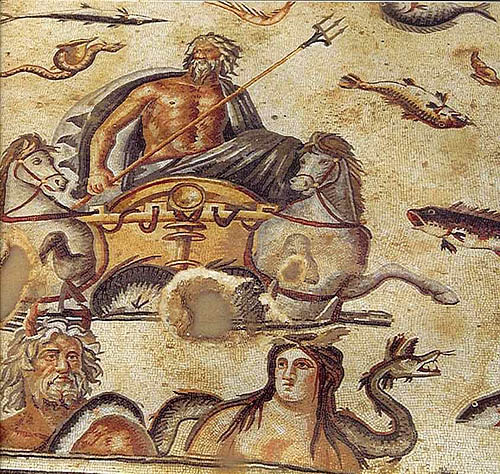
Oceanus or Okeanos refers to the ocean, which the Greeks and Romans regarded as a river circling the world. Strictly speaking, it was the ocean-stream at the Equator in which floated the habitable hemisphere (oikoumene. In Greek mythology this world-ocean was personified as a Titan, a son of Uranus and Gaia. In ancient Greek beliefs this Titan is often depicted as having the upper body of a muscular man with a long beard and horns, and the lower torso of a serpent.
Oceanus' consort is his sister Tethys, and from their union came the ocean nymphs, also known as the three-thousand Oceanids, and all the rivers of the world.
Some scholars believe he originally represented all bodies of salt water, including the Mediterranean Sea and the Atlantic Ocean, the two largest bodies known to the ancient Greeks. However, as geography became more accurate, Oceanus came to represent the stranger, more unknown waters of the Atlantic Ocean (also called the Ocean Sea), while Poseidon ruled over the Mediterranean.
In most variations of the war between the Titans and the Olympians ("Titanomachy"), Oceanus, along with Prometheus, and Themis, did not take the side of his fellow Titans against the Olympians, but instead withdrew from the conflict. In most variations of this myth, Oceanus also refused to side with Cronus in the latter's revolt against their father, Uranus.
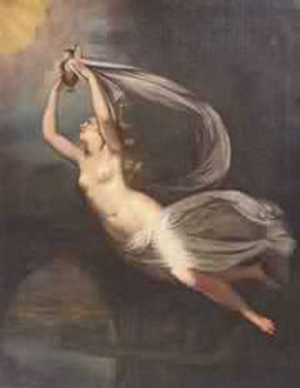
Phoebe, in her name simply the feminine counterpart of Phoebus, was one of the original Titans, one set of sons and daughters of Uranus and Gaia in Greek mythology. She was traditionally associated with the moon (see Selene), as in Michael Drayton's Endimion and Ph¦be, (1595), the first extended treatment of the Endymion myth in English. Her consort was her brother Coeus, with whom she had three children, Leto, Asteria and Hekate.
Through Leto she was the grandmother of Apollo and Artemis. The names Phoebe and Phoebus came to be applied as a synonym for Artemis and an epithet of Apollo. According to a speech that Aeschylus, in Eumenides, puts in the mouth of the Delphic priestess herself, she received control of the Oracle at Delphi from Themis: "Phoebe in this succession seems to be his private invention," D.S. Robertson noted, reasoning that in the three great allotments of oracular powers at Delphi, corresponding to the three generations of the gods, "Ouranos, as was fitting, gave the oracle to his wife Gaia and Kronos appropriately allotted it to his sister Themis." In Zeus' turn to make the gift, however, Aeschylus could not report that the oracle was given directly to Apollo, who had not yet been born, Robertson notes, and thus Phoebe was interposed. These supposed male delegations of the powers at Delphi are not borne out by the usual reconstruction of the sacred site's pre-Olympian history.
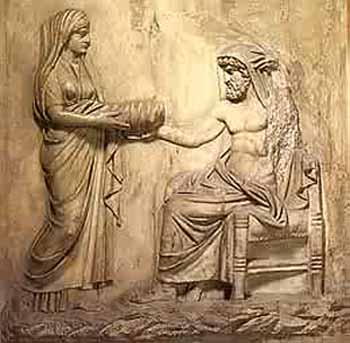
Rhea (or Ria meaning "she who flows") was the Titaness daughter of Uranus and of Gaia. She was sister to Cronus and mother to Demeter, Hades, Hera, Hestia, Poseidon, and Zeus. She was strongly associated with Cybele. In Roman mythology, she was Magna Mater deorum Idaea and identified with Ops.In art, Rhea was usually depicted on a chariot drawn by two lions, not always distinguishable from Cybele.
Her husband, Cronus, castrated their father, Uranus. After this, Cronus re-imprisoned the Hecatonchires, the Gigantes and the Cyclopes and set the monster Campe to guard them. He and Rhea took the throne as King and Queen of the gods. This time was called the Golden Age as the people of the time had no need for laws or rules; everyone did right and as such, there was no need.
Cronus sired several children by Rhea: Hestia, Demeter, Hera, Hades, Poseidon, but swallowed them all as soon as they were born, since he had learned from Gaia and Uranus that he was destined to be overcome by his own son as he had overthrown his own father. But when Zeus was about to be born, Rhea sought Uranus and Earth to devise a plan to save him, so that Cronus would get his retribution for his acts against Uranus and his own children. Rhea gave birth to Zeus in Crete, handing Cronus a stone wrapped in swaddling clothes which he promptly swallowed.
Then she hid Zeus in a cave on Mount Ida in Crete. According to varying versions of the story:
2. He was suckled by a goat named Amalthea, while a company of Kouretes, soldiers, or smaller gods danced, shouted and clapped their hands to make noise so that Cronus would not hear the baby's cry.
3. He was raised by a nymph named Adamanthea. Since Cronus ruled over the earth, the heavens and the sea, she hid him by dangling him on a rope from a tree so he was suspended between earth, sea and sky and thus, invisible to his father.
In Greek mythology, Zeus forced the Titan Cronus to disgorge the other children in reverse order of swallowing: first the stone, which was set down at Pytho under the glens of Parnassus to be a sign to mortal men, then the rest. In some versions, Metis gave Cronus an emetic to force him to disgorge the babies, or Zeus cut Cronus' stomach open. Then Zeus released the brothers of Cronus, the Gigantes, the Hecatonchires and the Cyclopes, who gave him thunder and the thunderbolt and lightning, which had previously been hidden by Gaia. Together, Zeus and his brothers and sisters with the Gigantes, Hecatonchires and Cyclopes overthrew Cronus and the other Titans.
In Homer, Rhea is the mother of the gods, though not a universal mother like Cybele, the Phrygian Great Mother, with whom she was later identified. The original seat of her worship was in Crete. There, according to legend, she saved the new-born Zeus, her sixth child, from being devoured by Kronos, by substituting a stone for the infant god and entrusting him to the care of her attendants the Curetes.
These attendants afterwards became the bodyguard of Zeus and the priests of Rhea, and performed ceremonies in her honour. In historic times, the resemblances between Rhea and the Asiatic Great Mother, Phrygian Cybele, were so noticeable that the Greeks accounted for them by regarding the latter as only their own Rhea, who had deserted her original home in Crete and fled to the mountain wilds of Asia Minor to escape the persecution of Kronos (Strabo. 469, 12). The reverse view was also held (Virgil, Aeneid iii), and it is probably true that cultural contacts with the mainland brought to Crete the worship of the Asiatic Great Mother, who became the Cretan Rhea.
In Greek mythology, Rhea's symbol is the moon. However, in Roman mythology, her symbol is known as the lunar (which would seem to mean "Moon"). She has another symbol, the swan, because it is a gentle animal. Also, her other symbol is two lions, supposedly the ones that pull her chariot.
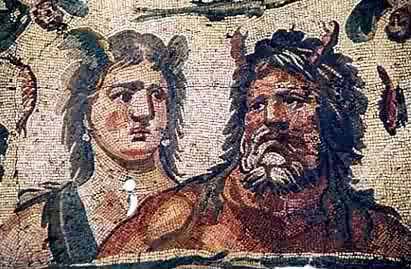
In Greek mythology, Tethys was a Titaness and sea goddess who was both sister and wife of Oceanus. She was mother of the chief rivers of the universe, such as the Nile, the Alpheus, the Maeander, and about three thousand daughters called the Oceanids.
Tethys, along with her husband Oceanus, ruled the seas before Poseidon; Roman mosaic from Daphne (near Antioch) made in the 4th century A.D.Tethys, a Titan sea-goddess who ruled the seas with her husband Oceanus; Roman mosaic from Antioch (House of Calendar) made between the 2nd and 3rd centuries A.D.During the war against the Titans, Tethys raised Rhea as her god-child.Tethys is sometimes confused with Thetis, the wife of Peleus and mother of Achilles.
Hera was not pleased with the placement of Callisto and Arcas in the sky, as the constellations Ursa Major and Ursa Minor, so she asked her nurse, Tethys, to help. Tethys, a marine goddess, cursed the constellations to forever circle the sky and never drop below the horizon, hence explaining why they are circumpolar.
In Greek mythology, Theia (also written Thea or Thia), also called Euryphaessa ("wide-shining"), was a Titan. With her brother and husband Hyperion, she was the mother of Helios (the Sun), Selene (the Moon) and Eos (the Dawn). According to the Homeric Hymn to Helios, Eryphaesa is listed as their mother. The name Theia alone, means simply "goddess," Theia Euryphaessa with overtones of brightness.
She seems here a goddess of glittering in particular and of glory in general, but Pindar's allusion to her as "Theia of many names" is telling, since it suggests assimilation not only to similar mother-of-the-sun goddess like Phoebe and Leto, but perhaps also to more universalizing mother-figures like Rhea and Cybele.
Theia's mythological role as the mother of the Moon goddess Selene is referenced in the application of the name to a hypothetical planet which, according to one theory, collided with the Earth, resulting in the Moon's creation.
Theia in Modern Paganism
Modern interpretations of Theia by many Neopagans, particularly sects in the United States, include the interpretation that she is the all seeing sister of Hyperion. Theia is sometimes seen as a kind and beautiful goddess, but her blessings are sometimes to be feared.
Worship of Theia may include prostration, and the burning of oils and incense, particularly at dawn or dusk. Worship of Theia is not as common as worship of many other Hellenistic gods. Some sects believe that Theia can grant the ability to see ghosts and spirits, as well as other forms of clairvoyance. Because of this many sects that worship Theia also encourage experimentation with the paranormal.
In Greek mythology, Hesiod mentions Themis among the six sons and six daughters - of whom Cronos was one - of Gaia and Ouranos, that is, of Earth with Sky. Among these Titans of primordial myth, few were venerated at specific sanctuaries in classical times, and Themis was so ancient that the followers of Zeus claimed that it was with him she produced the Three Fates themselves (Hesiod, Theogony, 904).
A fragment of Pindar, however, tells that the Moerae were already present at the nuptials of Zeus and Themis, that in fact the Moerae rose with Themis from the springs of Okeanos the encircling World-Ocean and accompanied her up the bright sun-path to meet Zeus at Olympus. With Zeus she more certainly bore the Horae, those embodiments of the right moment - the rightness of Order unfolding in Time - and Astraea. Themis was there at Delos to witness the birth of Apollo.
Themis (meaning "law of nature" rather than "human ordinance"), she "of good counsel," was the embodiment of divine order, law and custom. When Themis is disregarded, Nemesis brings just and wrathful retribution. Themis is not wrathful: she, "of the lovely cheeks" was the first to offer Hera a cup when she returned to Olympus distraught over threats from Zeus (Iliad xv.88). Themis presided over the proper relation between man and woman, the basis of the rightly ordered family, and the family the pillar of the deme, and judges were often referred to as "themistopoloi" (the servants of Themis). Such was the basis for order upon Olympus too. Hera addressed her as "Lady Themis."
The name of Themis might be substituted for Adrasteia in the birth of Zeus on Crete. She built the Oracle at Delphi and was herself oracular. Themis was one of the gods behind the Oracle at Delphi, which she received from Gaia and gave to Phoebe.
Many modern Neopagans, particularly Hellenistic Neopagans, believe that Themis is the goddess of virtue and justice. In many modern sects Themis is thought to take part in deciding the afterlife of one's mortal spirit. She carries a set of scales which weigh a persons virtuous deeds against a persons ill deeds. Themis is also thought to give the final input before the fate of a mortal is decided by Hades (The Judge).
Themis is often considered compassionate and virtuous towards mortals, and concerned with mortal wellbeing as well as mortal plights. Worship of Themis is not uncommon among many pagan sects in the United States, according to some pagan websites Themis may have as many worshippers that Artemis or Hera (two of the most popular pagan gods). Worshippers of Themis often attempt to lead virtuous and charitable lives.
Worship of Themis may take the form of chants, prayer, the burning of oils and incense, and the burning of food or spilling of drinks as offerings. Acts of Charity are also considered to be an active form of worship. Some sects that include worship of Themis encourage tithing, and many encourage proselytizing to non-believers. Proselytizing is typically rare among sects that do not include the worship of Themis. Followers of Themis often discourage hedonism, persecution, grudges, malice, spite, mockery, and revenge. Themis is thought to grant boons of good health, euphoria, virility, and charisma to her followers. Some pagan websites suggest that Themis is most commonly worshipped by males.

ALPHABETICAL INDEX OF ALL FILES
CRYSTALINKS MAILING LIST, NEWSLETTER, UPDATES